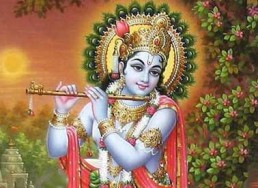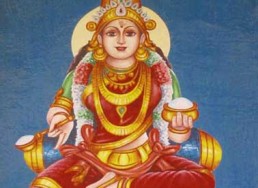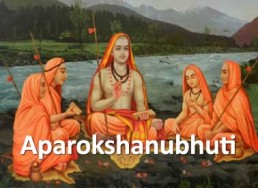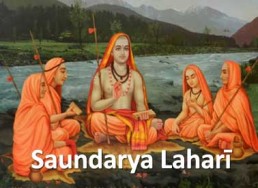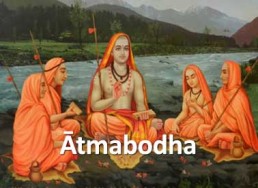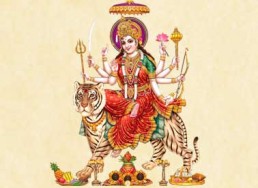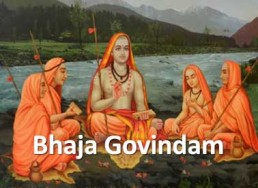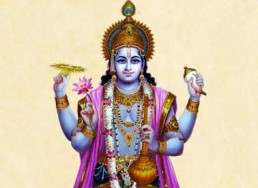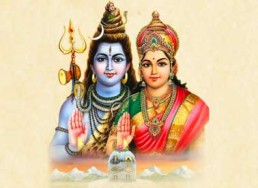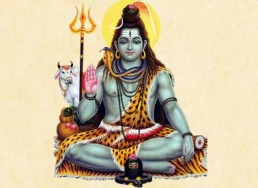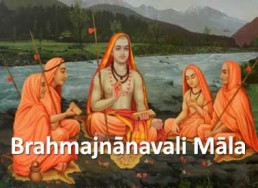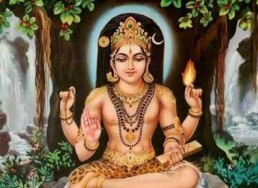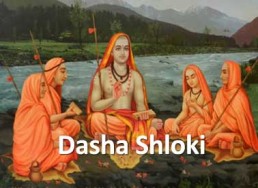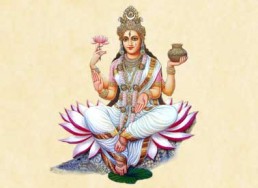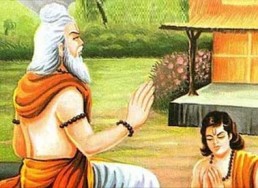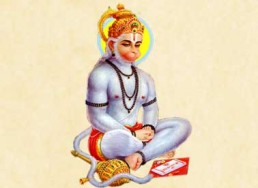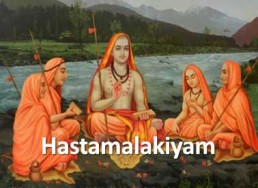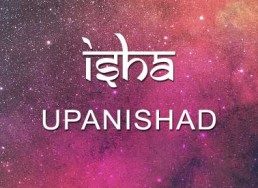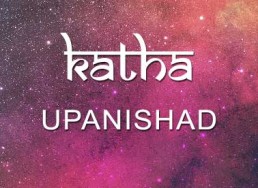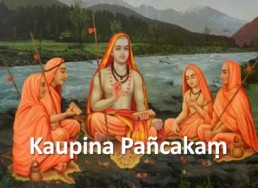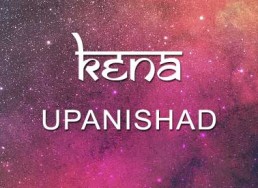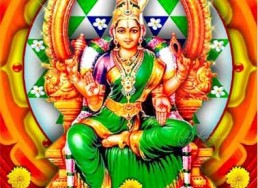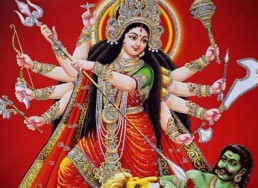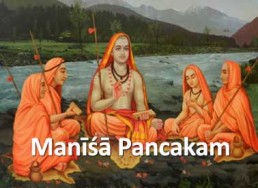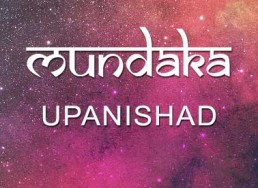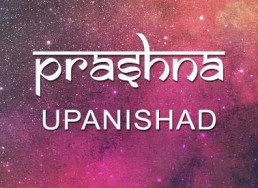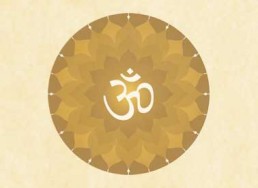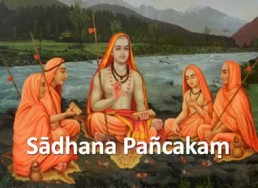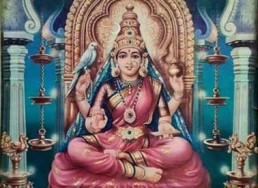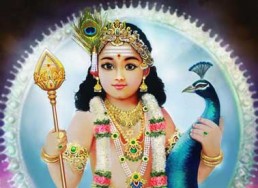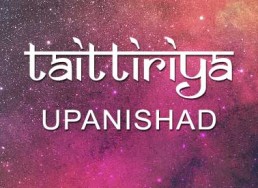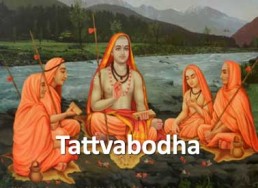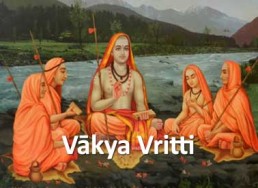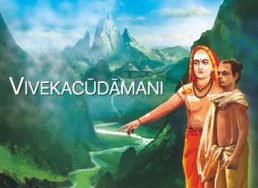Ekashloki
स्यादेवं रविदीपदर्शनविधौ किं ज्योतिराख्याहि मे ।
चक्षुस्तस्य निमीलनादिसमये किं धीर्धियो दर्शने
किं तत्राहमतो भवान्परमकं ज्योतिस्तदस्मि प्रभो ॥
syādevaṃ ravidīpadarśanavidhau kiṃ jyotirākhyāhi me .
cakṣustasya nimīlanādisamaye kiṃ dhīrdhiyo darśane
kiṃ tatrāhamato bhavānparamakaṃ jyotistadasmi prabho ..
Sishya: By day, the sun, by night, a lamp.
Guru: What is the light that sees these lights?
Sishya: The eye.
Guru: What is the light that illumines the eye?
Sishya: The intellect.
Guru: What is it that knows the intellect?
Sishya: It is the “I”.
Guru: Therefore, you are the light of lights.
Sishya: Truly, I am That. (I realize that I am)
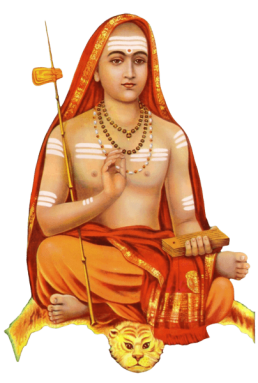
Description
Composed by Shri Adi Shankaracharya. He has successfully encapsulated the essence of Vedantic philosophy in this single (eka) Sloka, one Verse. Hence the name “ekasloki”. It is presented as a dialogue between a teacher (Guru) and student (Sishya), in response to a question by the student on realization of self. In short `that thou art’ or `ahambrahmasmi.’
Detailed explanation – Excerpt from the book “The Light of Wisdom” by Sri Ramana Maharshi, Nome
“What provides you with light?” “By day, the sun, by night, a lamp.” “What is the light that sees these lights?” “The eye.” “What is the light that illumines the eye?” “The intellect.” “What is it that knows the intellect?” “It is the ‘I.'” “Therefore, you are the light of lights.” When the teacher said this, [the disciple said,] “Truly, I am That.” If you trace the knowing inward, you arrive at the conclusive realization of yourself being pure Consciousness. What knows the world? What provides you with light? By day the sun, by night a lamp; what is this light that sees these lights? The eye. The experience of the universe is contained entirely within the sensations of it. The world, or universe, does not know itself. Something illumines it, knows it, through the senses. Apart from those sensations, the objective portion has no existence whatsoever and is certainly not self-known.
Asked, “What is the light that illumines the eye?” the eye and other senses, the answer is, “the intellect.” Something shines in and through the mind and knows all the sensations, which in turn compose the entire sphere of objective experience. Apart from the mind, there is no experience and knowledge of the senses and the world. The senses do not know themselves. Something else knows them. It appears as the mind. What knows the mind? By what light is the mind seen? That alone can be “I,” for the mind contains all that is objective. That which knows the mind, by whose light the mind is seen, must necessarily be nonobjective. The mind does not know itself. The “I” knows it. Here, the inquiry reaches its conclusion, for the “I” is self-known. The things, the senses, and the mind are not self-known. They depend on another to illuminate them. The “I,” that which knows even the mind, is self-known and does not depend on anything else in order to be known. It does not depend on another source of illumination. The “I” is only one. There are not two “I”s in you. There is just one “I,” self-existent and self-known. It is the light of the world that is beyond the world, the light of the senses un-grasped by the senses, and the light of the mind not conceived by the mind. It is Brahman, which no sense and no thought can grasp. This is your real place. This is your true identity. You are, therefore, the light of all lights, the single light that alone shines through all that it transcends.
That which is truly “I,” your identity, your existence, lies quite beyond the domain of words and thoughts. What is it that lies beyond words and thoughts? By whose light are the thoughts, the words, and all else known? The answer to the question is found not by guesswork or forming an idea but by complete absorption of your sense of identity in the light of Consciousness. The answer is of the nature of direct experience. The answer is of the nature of your very Being. Your abidance as That, the full absorption of your identity in That, is the nature of the answer to the inquiry. Consciousness is not an attribute, just as Existence is not an attribute. An attribute is a quality that belongs to something else or a power or an ability that belongs to something else. Consciousness does not belong to anything else. At no time does Consciousness cease, just as at no time does Existence cease to exist. Consciousness neither does anything nor does anything do something to it.
Observe how the entire experience of the world is illumined by, or known by, your senses. Without the sensations, there would be no experience of a world. The light of the world, inclusive of all that are bright, like the sun and the moon, is the senses. What illumines, or knows, your senses? Your mind knows the senses. If it were not for the mind’s knowledge, or illumination, there would be no experience of sensations. Trace the knowing further inward. What illumines the intellect? What is the light for your mind? The mind consists of innumerable thoughts of various permutations arranged in various modes and states. What illumines them? The mind does not know itself. What knows it? If it were not for this shining knowledge, there would be no experience of a mind.
Trace the knowing further inward. Beyond the mind, distinctions cease. You are left with your own Being. Your own Being is the all-illuminating Consciousness. What illumines Consciousness? Nothing else does. Nothing else knows it. It knows itself, by itself. It is not an object of perception or conception, but it is the light for all percepts and all concepts always. To know yourself to be that light is true Knowledge. Be free of mistaking yourself to be some illumined object. You are the illumination. If you misidentify as an object, from the mind to the forms of the world, the darkness of ignorance appears. If you know yourself to be the light of all lights, there is not a trace of darkness.
Distinguish what is objective and what is the Light. Though referred to as “light,” it is not something to be seen with the eyes or visualized by the mind. By “light” is meant pure Knowledge; not percepts and concepts, but Knowledge. The guru instructs in the manner of inquiry, what provides you with light, causing the Consciousness to become awake to itself and free from the darkness of delusion. It is the sadguru who informs the disciple, in the deepest possible way, that the disciple is truly the Light of lights. He reveals one’s very identity, one’s very Existence, the nature of Consciousness. By inquiring accordingly, following the instruction precisely, the state of “I-am-That,” identity with Brahman, is realized. It is a unique recognition, in that it is not constituted of ideas. It is not like recalling something from memory, though it is recalling something you always knew. It is the revelation of the Ever-revealed.
By “light” is indicated knowing. What is it that truly knows? In relation to the objects, the senses seem to be the knower, but the senses themselves are the objects for the mind, for which the mind seems to be the knower. Who knows the mind? It is the “I.” What then, is the nature of “I”? What is the source of all knowing within you? That which is the source is self-luminous, self-knowing, and does not depend on any other instrument or source in order to know. You cannot be the known; you can be only the knower. All of the known is contained in the knowing and all of the knowing in the knower. To define the knower in terms of the forms of the known is a mistake. To realize the knower as the knower alone is the revelation of pure Consciousness. Your identity truly is only pure Consciousness, referred to as “the knower” in relation to all that is known. Just by itself, it transcends all definition.
In the discovery of Consciousness in meditation, what is the nature of the discoverer? The discrimination is not between two objective things, but rather the discernment of that which is nonobjective. The result is that Being is itself the Knowledge. The Knowledge, which can never be extinguished, which is its own source, and which is infinite and eternal, is here referred to as light. Self-inquiry is non-conceptual, nonobjective Knowledge. It is not an activity; it is not a doing. Activities, of whatever kind, can yield only transient results. True Knowledge is of an eternal nature. Liberation is of an eternal nature. So, it is emphasized that action does not lead to Liberation. Self-Knowledge alone is Liberation. The complete dis-identification from all that is objective and the utter dissolution of an identity as an individual being are the inquiry and the Knowledge.
What is the nature of that which is aware of the object? What is the knower without an object to know? The assumption of the objective, as something existing, occurs to whom? One Consciousness is all-illuminating. It is the light in all knowledge of whatever kind. When you think that you know something, you are actually knowing only the Self as that thing. The nature of the knowing is only the Self, also, and so it is for the knower, as well. One Self, in illusion, appears as three, the knower, the knowing, and the known. Upon inquiry into the knower, the individuality, being unreal, vanishes and, along with it, the objectifying outlook that supposes, “I know an object,” or, “I have known objects in the past,” etc. What has actually occurred? Just the Existence the Self, which is the self-luminous Consciousness, is.
What is the light for you? What is the knower? Is your mind a knower? Someone knows the mind. The mind cannot be the knower. Beyond the mind, within you, what is there? Beyond the mind, there are no objects. Beyond the mind, there are not two. There is no multiplicity beyond the mind. Therefore, the verse concludes not with, “There is the light,” but, “I am That.” One’s own Being is the Knowledge.
Direct experience, not ideas, is desirable. We see objects; by what light do we see objects? Of course, there is physical light, but what is spoken of as light in the spiritual sense is knowledge. By your senses, you perceive all phenomena. So much so is this the case that we can say sensations compose the phenomena, and, apart from them, you have never experienced an object. The objects, therefore, are only sensations. The senses appear to know the objects; the objects do not know the senses. The senses do not know themselves. They are not self-effulgent. Something else knows them. Your mind knows your senses. So, the entire world is in the senses, and the entirety of the sensations is in your mind.
Your mind knows the senses and their objects; the senses and their objects do not know your mind. The mind is not self-effulgent either; something else knows the mind. Beyond the mind, there is no name and form. Beyond the mind is only pure Consciousness, and that is your identity. You are not of the world, the body, the senses, or the mind. That which ought to be known as “I” is only this self-luminous Consciousness, the Light of lights. When the disciple truly understands the Reality, as taught by the guru, he realizes, and what he realizes is summed up in the phrase, “Truly, I am That.” So, if we speak of Self-Realization as a state, it is a state of identity.
With all of the thinking that has ever been performed, you have not thought of your Self. You may have thought the word “Self,” but you have not thought of your Self. If spiritual thought does not touch you, how much less does worldly thought touch you? There is One who understands you, and that One is God. Seek inwardly for the Light of all lights. You are not the mind; your nature is pure Consciousness. If you seek the Light of lights within yourself, it will turn out that there is not a thing to be called “the mind.”
How do you see the world? By what light? If you see it by your senses, by what do you know the senses? You know the senses by your mind. Indeed, the senses are nothing more than a faculty within the mind itself. There is nothing external. What sees the mind?
The scriptures speak about the mind only to rid the aspirant of the false belief in it. The scriptures speak of objects, but do not do so with the intention of reinforcing the dualistic concept that objects exist. Rather, they speak of such only in the course of revealing the absolute Existence, which is God or Brahman. Likewise is it in the case of the mind, senses, the jiva, etc. Multiplicity is only possible with the senses and the mind. If the Light of which they speak is sense-transcendent and mind-transcendent, it can be only One. Since it is self-knowing, self-luminous, pure Knowledge, therefore the disciple said, “Truly, I am That.” If there is anything, all of it is entirely within That. If there is not anything, That alone is. If you are That, you are the motionless. The Existence is only One.
Other Sankara Shlokams
Achyutashtakam
Achyutashtakam, composed by Sri Adi Shankaracharya, is in praise of Lord Krishna. It is a simple yet wonderful hymn of eight stanzas comprising the names of lord Vishnu with main emphasis on his incar
Annapurna Stotram
Annapurna is the goddess of food and nourishment. She is a form of Parvati, the inseparable shakti of Lord Shiva. Anna is translated as "food" and "grains" and purna means "full" or "complete". Annapu
Aparokshānubhuti
Shlokams,Prakarana Grantha,Sankara
Aparokshanubhuti, or Direct Experience of the Absolute is an introductory work by Adi Shankaracharya that expounds Advaita Vedanta philosophy. The word means Self-Realization
Ashtavakra Gita Home
Shlokams,Prakarana Grantha,Sankara
The Ashtavakra Gita is an ancient Sanskrit scripture that presents a powerful conversation between the sage Ashtavakra and King Janaka on the nature of the Self, liberation, and ultimate truth. Unlike many other spiritual texts, it is remarkable for…
Ātmabōdha
Shlokams,Prakarana Grantha,Sankara
Atmabodha, meaning Self-knowledge or Self-awareness, is an exceptionally lucid and readable work of Shankaracharya. Consisting of sixty-eight verses or shlokas, it is in a sense a simple summary of his entire Vedantic structure of thought, intended,…
Atmabodha All Verses
Shlokams,Atmabodha Verse,Sankara
Atmabodha - Full text with meaning, audio and translation from Sanskrit to English, Telugu, Kannada, Tamil and more
Ayigiri Nandini
The Mahishasura Mardini Stotram also known popularly as Aigiri Nandini, holds immense significance during Navratri. The word Mahisha means buffalo and Asura means Rakshasa or Demon. Composed by the great sage Adi Shankaracharya around 810 AD, this…
Bhaja Govindam
Shlokams,Vishnu,Sankara,Govinda,Krishna,Prakarana Grantha
Bhaja Govindam is one of the most popular hymns penned by Adi Shankaracharya. He has packed into the Bhaja Govindam song the substance of all Vedanta, and set the oneness of Jnana and Bhakti to melodious music.
Bhavani Ashtakam
Composed by Sri Adi Shankaracharya. Bhavani Ashtakam is a popular hymn on Goddess Bhavani, who is known for her protection and merciful nature. The Lyrics of this hymn have an in-depth meaning that wh
Bilvashtakam
Composed by Sri Adi Shankaracharya, the famous Bilvashtakam extols the virtues of the Bilva leaf (also spelt Vilva, Bilwa) and Lord Shiva’s love for it. The following com
Bilvashtakam 14 Verses
Note: For the original version of Bilvashtakam please click here. Composed by Sri Adi Shankaracharya,
Brahmajnānavali Māla
Shlokams,Prakarana Grantha,Sankara
In this Prakarana Grantha (topical text or treatise) attributed to Sri Sankara the characteristics of the person who has realized that he is Brahman are described. The aspirant for liberation is advised to meditate on these in order to attain that…
Dakshinamurthy Stotram
Shlokams,Sankara,Shiva,Dakshinamurthy
The Dakshinamurti Stotra is a Sanskrit religious hymn to Shiva by Sri Adi Shankaracharya. It explains the metaphysics of the universe in the frame of the tradition of Advaita V
Dasa Shloki
Shlokams,Prakarana Grantha,Sankara
This composition in ten verses - dasha shloka - is similar to the Nirvana Shatakam, and like it, a summation, in typically Shankara's way, of the unyielding non-dual vision of Advaita. Here too, Shankara's attempt is to deny everything else only to…
Devi Aparadha Kshamapana Stotram
Composed by Sri Adi Shankaracharya. Aparadha Kshamapana stotram is usually recited after a recital or after the completion of Puja. Its like asking for forgiveness from Goddess for various mistakes th
Ganesha Pancharathnam
The composer, Guru Sri Adi Shankaracharya had praised the God Ganesha by presenting these five stanzas as five jewels, hence the name Maha Ganesha Pancharatnam.
Ganesha Stavah
Ganesha Stavah or Ganapati Stavah is a set of 13 verses that describe the glory of Lord Ganesha. Gaṇapati stavaḥ is said to be from Ganesh Purana - upāsanā khaṇḍa adhyāya 13.
Ganga Ashtakam
Gangashtakam is an octet on river Ganga composed by Shri Adi Shankaracharya.
Gangā stotram
Sri Adi Shankaracharya has written a song ”Devi Suresvari Bhagavati Gange” and the Official Name for this song is ”Sri Sri Ganga Stotram”. In this song Sree Shankaracharya describes the glories of Sri
Guru Ashtakam
The Guru Ashtakam is a Sanskrit hymn composed by Adi Shankaracharya, the 8th-century Indian philosopher and saint who consolidated the doctrine of Advaita Vedanta. In the Vedan
Guru Paduka Stotram
Guru Paduka Stotram is a very powerful chant that glorifies the "Padukas (Sandals) of the Guru," which are symbolically represented as "the boat to help cross the endless ocean
Hanuman Pancharatnam
Garland of five gems on Shri Hanuman composed by Shri Adi Shankaracarya.
Hastāmalakiyam
Shlokams,Prakarana Grantha,Sankara
Composed by Hastāmalaka Ācārya, a direct disciple of Adi Sankaracharya, the Hastāmalaka Stotraṁ or Hastāmalakiyam is a short Vedāntic text about the higher nature of the Self.
Ishavasya All Verses
Introduction to Isavasya Upanishad The Īśāvāsyopaniṣad—so called from its initial words—forms the concluding chapter of the Saṃhitā of the Suklayajurveda The name of
Ishavasya Upanishad
The Isha Upanishad is embedded as the final chapter of the Shukla Yajurveda and is one of the shortest Upanishads, with 18 verses. It is the very first Upanishad in the Muktika canon of 108 Upanishads.
Ishvaro Guru Atmeti
Shlokams,Shiva,Dakshinamurthy,Guru,Sankara
Salutations to Lord Dakshinamurti, who is all-pervasive like space but who appears (as though) divided as Lord, Guru, and the Self.
Jagannath Ashtakam
Shri Jagannath Ashtakam was composed by Adi Sankracharya in praise of Lord Jagannath on his visit to Puri. The merit of reciting the sacred Jagannath ashtakam carefully is such that, one becomes sinle
Kalabhairava Ashtakam
Composed by Sri Adi Shankaracharya. The hymn illustrates the personality of Kala Bhairava of Kashi, the God of Death(kala). Those who study these 8 verses on Kala Bhairava, which are enticing and whic
Kalika Ashtakam
Composed by Sri Adi Shankaracharya on devi Kalika. The Goddess Kali is the guardian, also known as Kalika. The protectors, the Mother, Kali is Dharma and eternal time. Kali shines with the brilliance
Kamakshi Stotram
Composed by Sri Adi Shankaracharya. Goddess Kamakshi is a form of Tripura Sundari or Parvati or the universal mother goddess. The word is derived from the heritage “Ka” meaning Goddess Saraswati (Godd
Kanakadhara Stotram
Kanakadhara Stotram is a hymn (Stotra) composed in Sanskrit by Sri Adi Sankaracharya. Kanakadhara means “stream” (dhara) of “gold” (kanaka). The 21 stanzas of kanakadhārā stotram then became famous and are read by all devout Hindus for……
Kasi Viswanathashtakam
Composed by Sri Adi Sankaracharya in praise of Lord Shiva. That man who reads this octet with its meaning, which sings the praise of Shiva who is the lord of Varanasi, would get knowledge, wealth, gre
Katha Upanishad
The Katha Upanishad is embedded in the last 8 sections of the Krishna Yajurveda. It has two chapters divided into three Vallis each. It is a Mukhya upanishad and listed as #3 in the Muktika canon of 108 Upanishads.
Kathopanishad All Verses
The Katha Upanishad is a collection of philosophical poems representing a conversation between the sage Naciketas and Yama (god of death). They discuss the nature of Atman, Brahman and Moksha (liberation). The book is made up of six sections…
Kaupina Panchakam
Shlokams,Prakarana Grantha,Sankara
Kaupina Panchakam - This is a very short poem composed by Sri Adi Sankaracharya, with five stanzas that glorify the life of a Sannyasi. The Kaupina is made up of a rectangular strip of cotton cloth used to cover the genitals with the help of the…
Kena Upanishad
The Kena Upanishad is embedded inside the last section of the Talavakara Brahmanam of the Samaveda. It is a Mukhya upanishad and listed as #2 in the Muktika canon of 108 Upanishads.
Kenopanishad-All-Verses
The Kena Upanishad or Kenopanishad (Kenopaniṣat) (also known as the Talavakara Upanishad) elucidates the concept of nirguna (qualityless) Brah
Lakshmi Narasimha Karavalambam
Narasimha is a fierce avatar of the Hindu god Vishnu, one who incarnates in the form of part lion and part man to destroy evil and end religious persecution and calamity on Earth, thereby restoring Dh
Lalitha Panchakam
Composed by Sri Adi Shankaracharya in praise of mother Lalitha. The phalastuti of the stotram says the divine mother will give good knowledge, wealth, fame, happiness, fortune, and prosperity.
Lalitha Sahasranamam
Lalitha Sahasranamam is a sacred Hindu text from the Brahmanda Purana which lists the thousand names of the Hindu mother goddess Lalita Devi, a manifestation of the Divine Mother (Shakti), and is therefore used in the worship of Durga, Parvati,…
Mahishasura Mardini Storam
Mahishasura Mardini Stotram - This is a prayer to the Goddess who killed Mahishasura. “The place where Sri Mahishasura Mardini Stotram is sung every day, I will always be present and never leave.” - The Devi’s proclamation in the 12th chapter of the…
Manishā Panchakam
Shlokams,Prakarana Grantha,Sankara
Adi Sankara’s ‘Manisha Panchakam’ refers to the conclusive wisdom or determinate knowledge asserted in five verses. Manisha means conclusive wisdom or determinate knowledge and Panchakam refers to the five verses.
Mauna Vyakhya
Shlokams,Sankara,Shiva,Dakshinamurthy
I salute Sri Dakshinamurti, who is not subject to time, who makes known the truth of Brahman through the implied meaning of words, who is surrounded by disciples who are themselves Rishis and committe
Meenakshi Pancharatnam
Meenakshi Pancharatnam (The five jewels of Meenakshi) is a popular stotram composed by Sri Adi Shankaracharya as a ritual incantation on goddess Meenakshi. This stotram explains the divine qualities,
Mundaka Upanishad
The Mundaka Upanishad is embedded is embedded in the Atharva Veda. It is a Mukhya upanishad and listed as #5 in the Muktika canon of 108 Upanishads.
Narmada Ashtakam
Composed by Sri Adi Shankaracharya in praise of river Narmada.
Nidhaye Sarvavidyanam
Shlokams,Sankara,Shiva,Dakshinamurthy
Salutations to Sri Dakshinamurti, the reservoir of knowledge (the abode of all learning), the healer of all those who suffer from the disease of samsāra, and the teacher of the whole world.
Nirvana Shatakam
Nirvana Shatkam (Atma Shatakam) of Adi Sankara Commentary and Notes Translated by S. N. Sastri Introduction: Sri Sankara Bhagavatpada has blessed poster
Om Namah Pranavarthaya
Shlokams,Sankara,Shiva,Dakshinamurthy
Om. Salutation to the one who is the meaning of praņava, who is in the form of pure knowledge, who is taintless and who is free from any change. To that Sri Dakshinamurti, (my) salutations.
Om Namo Bhagavate Dakshinamurthaye
Shlokams,Sankara,Shiva,Dakshinamurthy
Om. Salutations to Bhagavan Dakshinamurti. (Oh Lord) Bless me with memory, the capacity to think properly, and clarity, wisdom.
Pandurang Ashtakam
Shri Pandurang ashtakam (Pandurangashtakam) Stotra is a very beautiful creation of Shri Adi Shankaracharya. Lord Vithal, or Panduranga Vittala, is an incarnation of Lord Vishnu and is worshipped in t
Prashna Upanishad
The Prashna Upanishad is embedded is embedded in the Atharva Veda. It is a Mukhya upanishad and listed as #5 in the Muktika canon of 108 Upanishads.
Prashnopanishad-All-Verses
The Prashnopanishad (Prashna Upanishad) is a key philosophical text within the Indian spiritual tradition, part of the larger body of literature known as the Upanishads.
Prātah Smaranam
This is a prayer composed by Sri Adi Shankaracharya consisting of three stanzas in which the mind (manas) speech (vak), and body (kaya) of the individual are sought to be dedicated to the supreme Spir
Ranganatha Ashtakam
Ranganatha Ashtakam was written by Adi Sankara Bhagavatpada when he stood before Sri Ranganatha swamy in Srirangam, during his travels. This Ashtakam reveals that Adi Sankara was overwhelmed by Lord R
Sādhana Panchakam
Shlokams,Prakarana Grantha,Sankara
Sadhana Panchakam - Adi Sankara in these five simple looking verses lovingly lists the ways and means which can readily be followed by all students of Vedanta, seeking direct experience of the divine state beyond the mind, the spring of…
Sankaram Sankaracharyam
Salutations again and again to Lord Shiva in the form of Sri Sankaracharya and Lord Vishnu in the form of Veda Vyasa, who were the authors of sutra and bhasya.
Saundarya Lahari
Shlokams,Prakarana Grantha,Sankara
The Saundarya Lahari, a devotional poem of one hundred hymns, is ascribed to the great teacher Shankaracharya. The poem is divided into two parts; the first part, comprised of verses 1 through 41, is called the Anandalahari, or Wave of Bliss, and…
Sharada Bhujangam
Composed by Sri Adi Shankaracharya on devi Sharada. Sringeri is the first math (monastery) built by Sri Adi Shankaracharya. It has the famous temple of Devi Sharada inside it. The math is situated on
Shiva Aparadha Kshamapana Stotram
The Śiva Aparādha Kṣamāpaṇa Stotram, or "Hymn of Forgiveness for Offenses to Lord Śiva," is a heartfelt composition by the revered philosopher and saint Śrī Ādi Śaṅkarācārya. T
Shiva Ashtakam
Composed by Adi Shankaracharya. This ashtakam is a descriptive salutation of the different attributes of Shiva. The great yogi who is referred to as Ardhanarishwara (the one who has included the femin
Shiva Manasa Puja
Sri Adi Shankaracharya composed this mantra for lord Shiva. Using this stotra, we can perform mental worship of Lord Shiva.
Shiva Pratah Smaranam
This is a short and beautiful 'Three Shloka Prayer' that makes the start of the day full of energy and happiness. Composed by Sri Adi Shankaracharya.
Soundarya Lahari All Verses
Soundarya Lahari, meaning "Waves of Beauty," is a revered Sanskrit literary work attributed to Adi Shankaracharya, the great philosopher and theologian who consolidated the doctrine of Advaita Vedanta in the 8th century. This composition is not just…
Sruti Smrti
I bow at the feet of the Lord in the form Sri Sankaracharya, who is the blessing for the humanity, who is the shrine for the sruti, the smrti and the purana, and, who is the abode of compassion.
Subramanya Bhujangam
Sri Subramanya bhujangam is a stotra sung under inspiration by Sri Adi Shankaracharya at Thiruchendur ( presently located in Tamil Nadu, India). When he meditated upon SrI Subrahmanya, he became aware
Taittiriya Upanishad
The Taittiriya Upanishad is one of the primary Upanishads, as part of the Yajur Veda. It says that the highest goal is to know the Brahman, for that is Truth. It is divided into three sections, 1) the Siksha Valli, 2) the Brahmananda Valli and 3)…
Tattvabodha
Shlokams,Prakarana Grantha,Sankara
For anyone wishing to understand the essential tenets of Shankaracharya's philosophy and the Advaita vision, the Tattvabodha, which broadly translates to the 'knowledge of truth', is mandatory reading. In it, Shankara, as the teacher, puts down the…
Totakashtakam
The Toṭakāṣṭakam was composed by Giri (an enlightened disciple) in praise of his Guru Adi Sankara. Literally, it means a rhyme of eight (Sanskrit: aṣṭa) verses (ślokas) in the meter called Totaka.
Vākya Vritti
Shlokams,Prakarana Grantha,Sankara
Of the four Mahāvākyas, the statement containing the entire instruction of the teacher is 'Tat Tvam Asi' or 'That Thou Art'. Exposition of this pithy but pregnant sentence (vākya), is accomplished by Adi Sankara in a collection of 53 verses called…
Vedasara Shiva Stava
Composed by Sri Adi Shankaracharya in praise of Lord Shiva - the essence of vedas.
Vishnu Shatpadi Stotram
The Sri Vishnu Shatpadi is a revered Sanskrit stotra (hymn) dedicated to Lord Vishnu, the preserver and protector in Hinduism. Composed by the illustrious philosopher and saint, Sri Shankaracharya, this hymn comprises six verses (ṣaṭpadī) that…
Vivekachudamani
Shlokams,Prakarana Grantha,Sankara
The Vivekachudamani is the crown jewel of the Prarkarana texts (philosophical treatises) authored by Sri Adi Sankaracharya. The title translates to ‘Crest Jewel of Discrimination’, referring to the discrimination between the real and unreal.
Yamuna Ashtakam
Composed by Sri Adi Shankaracharya. In Yamunastakam’s first eight shlokas, Sri Adi Shankaracharya describes Shri Yamunaji’s eight fold powers, its divine & wonderful idol and her divine qualities. Shr
Ekashloki – Sankara – In Sanskrit, English Translation, Meaning, Significance and Audio.

